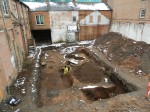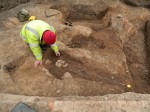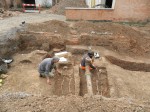 At this point, Leicester should probably just become a pedestrian-only city and tear up every patch of tarmac they have. The archaeological unit of the University of Leicester has made another unusual find under a city parking lot: a Roman-era cemetery that includes both pagan and Christian burials. Surveying the small site at the corner of Oxford Street and Newarke Street slated for future development, archaeologists unearthed 13 sets of human remains of mixed age and sex. Some of them were buried east to west in a supine position, a traditional Christian style of burial, whole others were buried north to south on their sides with grave goods in the pre-Christian tradition. The burials date to around 300 A.D.
At this point, Leicester should probably just become a pedestrian-only city and tear up every patch of tarmac they have. The archaeological unit of the University of Leicester has made another unusual find under a city parking lot: a Roman-era cemetery that includes both pagan and Christian burials. Surveying the small site at the corner of Oxford Street and Newarke Street slated for future development, archaeologists unearthed 13 sets of human remains of mixed age and sex. Some of them were buried east to west in a supine position, a traditional Christian style of burial, whole others were buried north to south on their sides with grave goods in the pre-Christian tradition. The burials date to around 300 A.D.
The area, now in the historic center of Leicester, was in Roman times 142 yards outside the south gate of the city walls. By Roman custom, all burials took place outside the perimeter to ensure the dead would not pollute the living. Cemeteries would grow outside the city, usually near major roads to ensure easy access for the families to return to the graves regularly for ritual libations and commemorative feasts.
 Indeed, the cemetery extends considerably past this one parking lot. Land on Newarke Street to the east and north of the lot has been excavated before and Roman burials were discovered, so archaeologists were not surprised to find more bodies under the asphalt, but the previously uncovered burials east and north of this one were all Christian. This is the first mixed section found.
Indeed, the cemetery extends considerably past this one parking lot. Land on Newarke Street to the east and north of the lot has been excavated before and Roman burials were discovered, so archaeologists were not surprised to find more bodies under the asphalt, but the previously uncovered burials east and north of this one were all Christian. This is the first mixed section found.
Two burials are especially strong examples of their diverse religions.
“One in particular appears to have been buried in a Christian tradition, facing east and wearing a polished jet finger ring on their left hand which has a possible early Christian Iota-Chi monogram etched onto it, taking the initial letters from the Greek for Jesus Christ. If so this would represent rare evidence for a personal statement of belief from this period.
“In contrast a nearby and probably near contemporary grave appeared to indicate very different beliefs. This grave had a north-south orientation, with the body laid on its side in a semi-foetal position, with the head removed and placed near the feet alongside two complete pottery jars that would have held offerings for the journey to the afterlife. This would seem to be a very pagan burial, so it is possible from the variety of burials found that the cemetery catered for a range of beliefs that would have been important to people living in Leicester at this time.”
 The digging is done, but the learning has just begun as the artifacts and bones are now beginning the process of cleaning and analysis. Once the finds have been cleaned and stabilized, archaeologists and other scientists will run a variety tests to determine the age and sex of the remains and any possible cause of death writ in the bones. Isotope analysis on the teeth will give us information on how they lived — their diet, where they came from — and osteological examination will tell us what kind of work stress their bodies were under, how well-nourished they were, how healthy. The team also took soil samples from the abdominal areas of the skeletons just in case some ancient digestive tract parasites could be gleaned from them.
The digging is done, but the learning has just begun as the artifacts and bones are now beginning the process of cleaning and analysis. Once the finds have been cleaned and stabilized, archaeologists and other scientists will run a variety tests to determine the age and sex of the remains and any possible cause of death writ in the bones. Isotope analysis on the teeth will give us information on how they lived — their diet, where they came from — and osteological examination will tell us what kind of work stress their bodies were under, how well-nourished they were, how healthy. The team also took soil samples from the abdominal areas of the skeletons just in case some ancient digestive tract parasites could be gleaned from them.
The Roman burials were the most exciting find, but they weren’t the only ones. Remains of a medieval suburb were unearthed, including a 12th-13th century quarry, cesspits and garbage dumps that were once dug in people’s backyards. Those pits, as unglamorous as they may be, are replete with archaeological gems in the form of pottery fragment, bone, poop and all kinds of discarded day-to-day objects that can tell us a great deal about the daily life of medieval Leicester. Archaeologists also found a 17th century ditch that was part of the city’s defensive fortifications during the English Civil War.